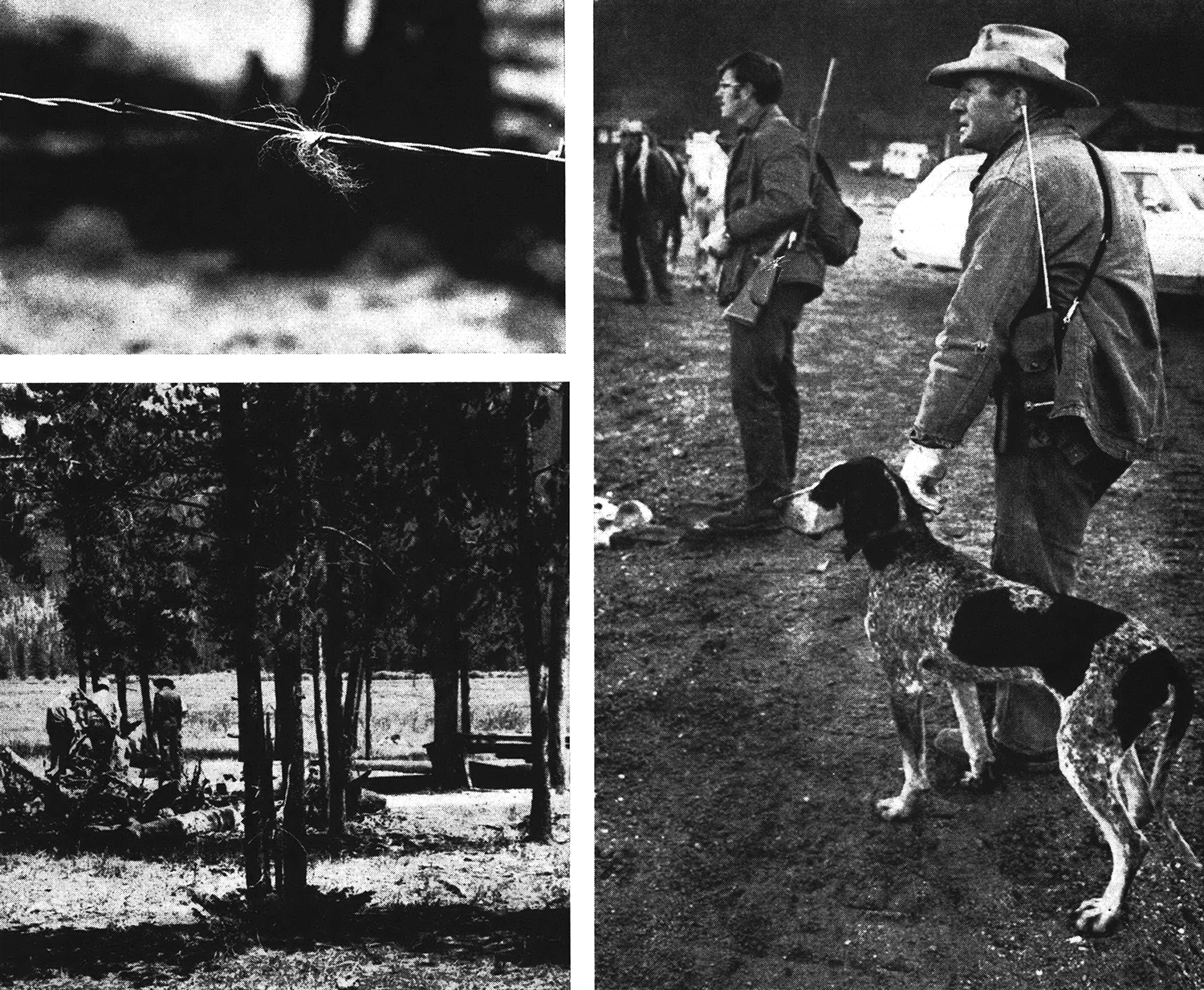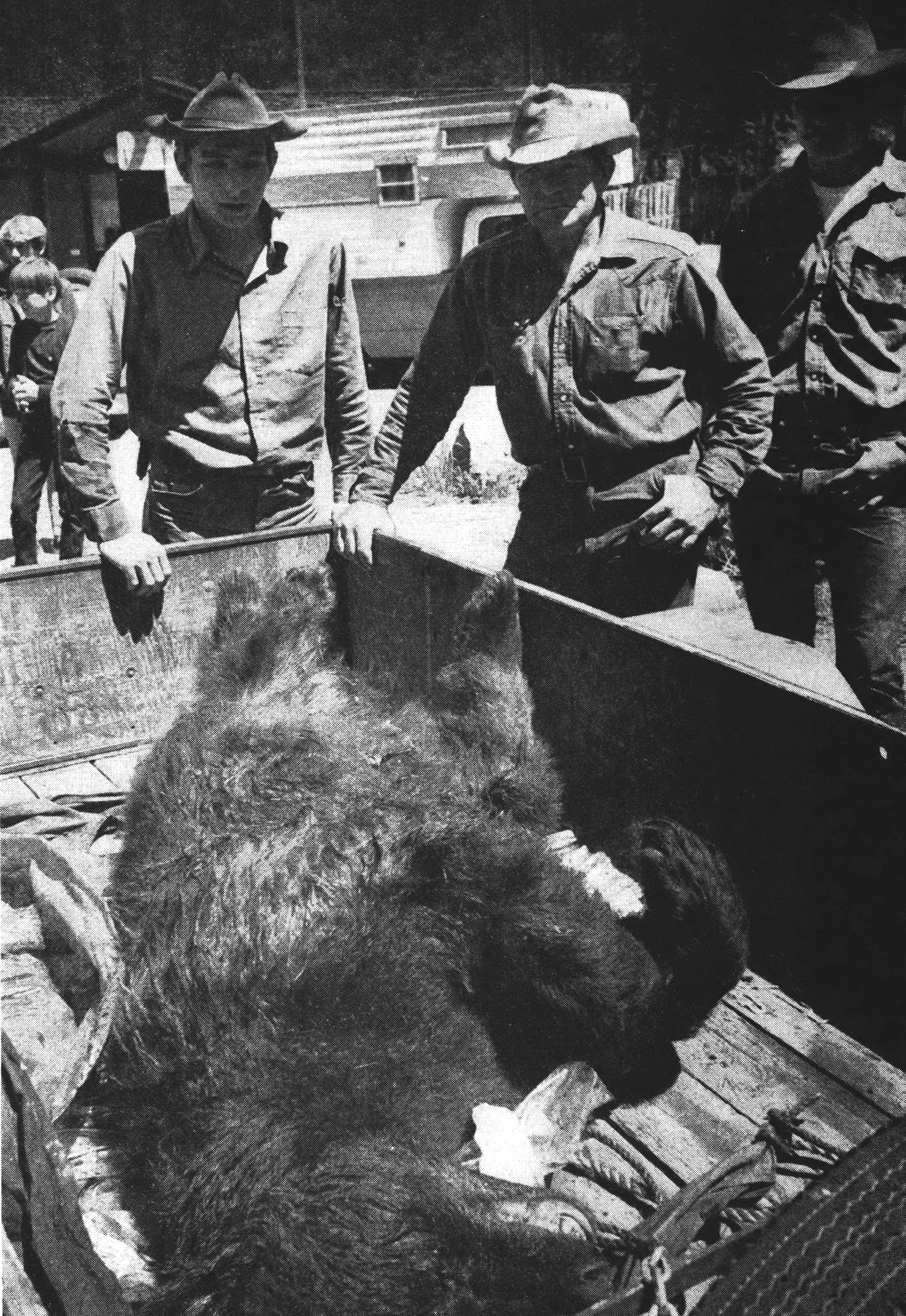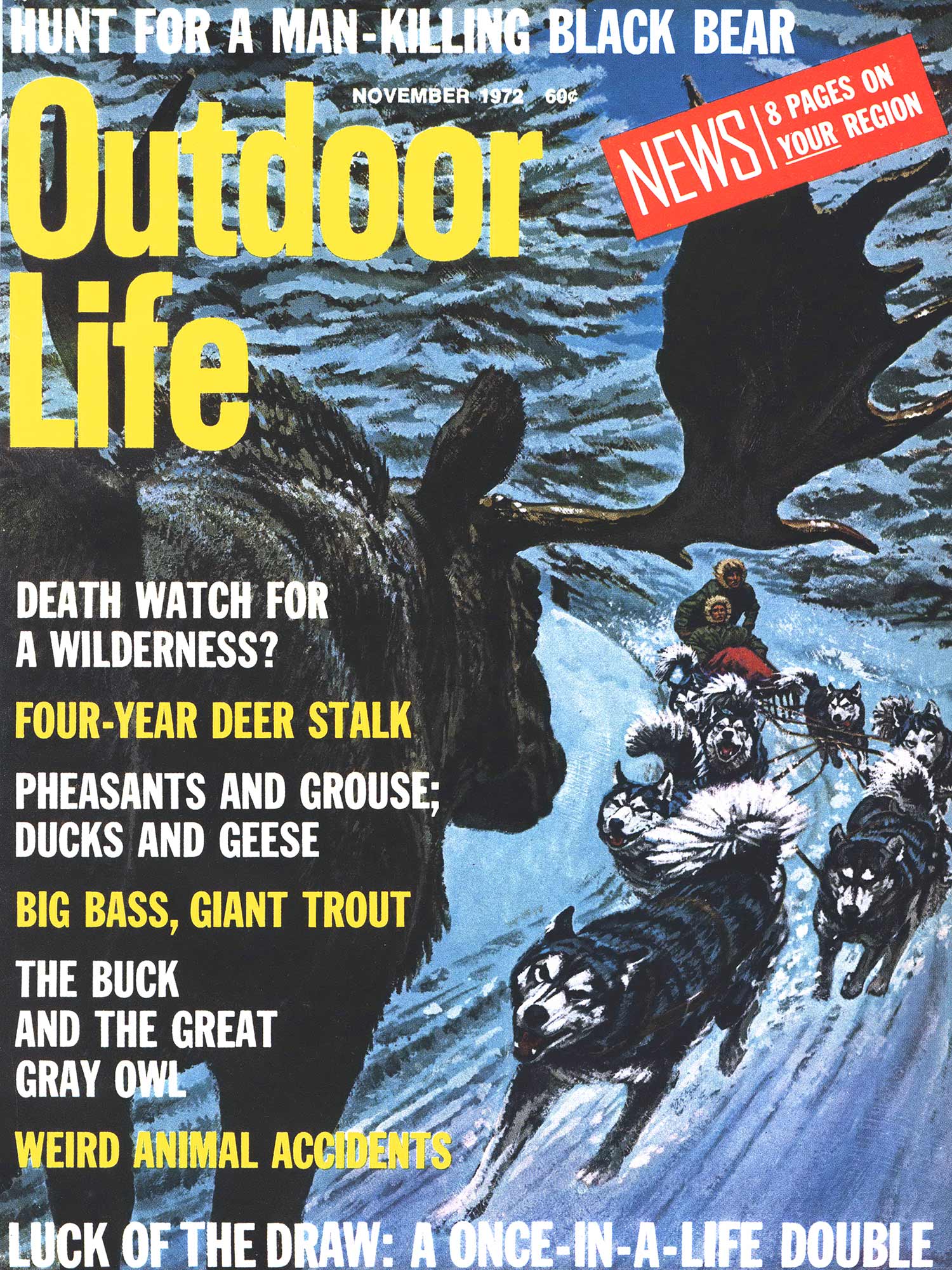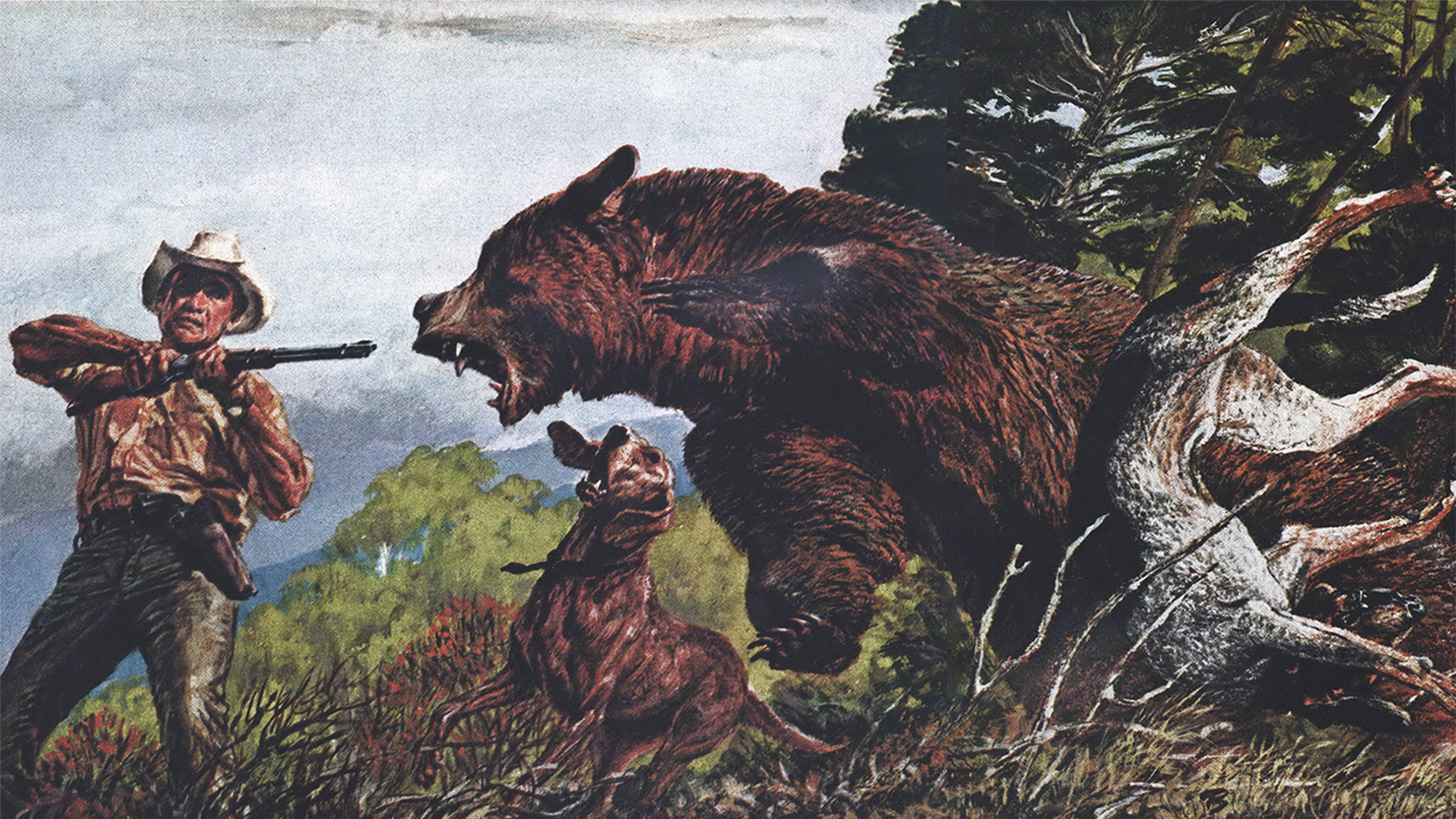SUNDAY, JULY 25, 1971, began like any other summer Sunday in the quiet mountain village of Collbran, Colorado, where I operate a guiding-and-outfitting business. I was trimming a wild-rose hedge in my yard. Bear hunting didn’t cross my mind, since our bear seasons are closed in the summer. If somebody had walked up to me and said that within moments I’d be organizing the most important bear hunt of my life, I’d have thought he was crazy.
The sudden change from relaxation to serious business came when my daughter Shirley saw me in the yard.
“Gosh, Dad,” she exclaimed, “I thought you had gone trout fishing. Some man just phoned. He sounded shook up. He wants you to call back right away. I wrote his number down.”
I dialed the number and found myself talking with Glenn Rogers, a regional manager for the Colorado Division of Game, Fish and Parks. That’s when I first thought of bears. Several times in the past Glenn had asked to use my dogs to go after stock-killing bears. But I wasn’t at all prepared for the shocking story he blurted out.
“It’s a real mess this time, Ray,” he began. “We’ve got a man-killing bear to deal with. It happened about two o’clock this morning in a private campground north of Grand Lake. A big bear walked up to a man’s tent, ripped it wide open, and attacked. The man didn’t have a chance. He was killed on the spot and then carried fifty yards before the bear left him. Can you take your hounds and go after the bear? We don’t want any more deaths.”
I’d made my decision before Rogers asked the question. I told him it would take a couple of hours for me to get organized. He said he’d phone back and tell me exactly where to go.
I immediately called my oldest son, George. He was working on a rush irrigation project at a nearby ranch and couldn’t get away. My second son, Raymond Jr., was at home, and he volunteered instantly. We call him Tad. He’s only 16, but he’s a veteran of many bear hunts and is very able with the hounds.
I figured I needed one more man, and I knew who. I called Warren Bruton, a 29-year-old top woodsman who operates a guide service for deer and elk hunters from his ranch near Molina. Warren told me he had a few matters to clear up, but he would be ready to roll by noon.
Right after that, Glenn Rogers called back and told me that accommodations, meals, and more manpower would be supplied by the National Park Service and the Colorado Game, Fish and Parks Department. I learned that the tragedy had occurred near the western edge of Rocky Mountain National Park in the north-central part of the state. We were to go directly to the park.
Tad, Warren, and I were on our way about 1 o’clock. Our four-wheel-drive pickup was loaded with my 10 hounds, sleeping bags, and a change of clothes for each of us. Collbran is in the west-central part of the state, so we had to drive at least five hours through the mountains. It wasn’t until we were rolling down the highway that I developed the first twinges of anxiety about the coming hunt.

Going after a black bear with hounds offers just about all the excitement a man could want, but running down a killer bear differs from a sporting chase. A bear doesn’t turn killer without reason. A known mankiller obviously has little fear of man, and hunting one can be dangerous.
I recalled an incident that still makes my hair crawl. Several years ago my hounds tracked a mean male, and they finally spotted him from a distance of 250 yards. I could tell by the wild tonguing. Normally a bear will run when dogs attack. This one didn’t run one step. He was ready to tear the whole world apart right on the spot.
I was sitting on my horse, waiting to see which way the bear would run. I couldn’t see the bear, but from the sounds the dogs made I knew they were charging in straight at the animal. Right after that, the furious howls of courageous fighting changed to yelps of terror. I leaped from my horse, hit the ground running, and lit out downhill. It took only seconds for me to reach the scene, but when I got there the fight was all over and the bear was gone.
Two dogs lay dead. Two more were writhing on the ground. Another’s back was nearly broken, and one had an eye knocked far back into his head.
Such experiences have taught me that you never know what a really angry bear will do. I was also concerned because I’d never dealt with a man-killer before.
Several other things also contributed to my mounting tension. I was unfamiliar with the country where the fatal attack had occurred. And I didn’t like the idea of so many people being involved in the hunt. What if something went wrong and an inexperienced hunter got killed?
I was aware that the tragedy was being splashed over the front pages of newspapers and was bulletin news on radio and TV. I was on the spot because I was the one who had to get the bear.
I WAS BORN 54 years ago at the winter headquarters of my father’s cattle ranch near Grand Junction, Colorado. While growing up around cow camps, I met many old-time bear hunters. I was still very young when I decided that a bear hunt is the best of all adventures.
During the next few years I acquired some dogs and took many scoldings for “fooling with houn’ dawgs.” My father believed that running hounds is the first step toward the poor house. I was 14 when I helped dad wrangle horses and pack out venison for some visiting deer hunters. I have served as a guide or outfitter every year since—except 1944, when I was piloting B-17’s over Germany during World War II.
After the war I accepted a job with the U.S. Fish and Wildlife Service as a predatory-animal control agent. I acquired another pack of hounds, and I used them to track down many troublesome bears. Incidentally, all the bears in Colorado are black bears.
Eventually I returned with my family to the valley where I had grown up. I bought a ranch and tried raising cattle, but I was too interested in hunting. I sold the ranch in 1957 and went into full-time guiding and outfitting. My sideline specialty was assisting stockmen in tracking and killing bears that were menacing livestock. It was through this activity that I became known to personnel in the state Game, Fish and Parks Department.
It was nothing very new for me to be called out on a bear hunt. I guess that nearly 400 black bears have been killed over my dogs by myself and other hunters.
Tad, Warren, and I had trouble with the truck three times during the drive across the mountains, and it was dusk when we arrived at the edge of the park and spotted a park-department patrol car. Its driver had been alerted to watch for us. He escorted us 11 miles to the Holzwarth Neversummer Ranch, a dude ranch near the scene of the tragedy. A dozen or more National Park Service personnel and state game men were waiting for us. John Holzwarth III, part owner of the ranch, was present to provide information on the attack and describe the surrounding terrain.
Knowledge of the terrain was very important, but at the moment, I was much more interested in the details of the killing. The story was told by Bert McLaren, a National Park Service official who was in overall charge of the hunt.
“The man’s name was John Richardson,” he began. “He was a thirty-one-year-old resident of Denver. He was camping on ranch property with his brother-in-law and several other relatives. Most of the members of the group were asleep in a bus-type camper. Richardson was spending the night in a tent pitched close to the camper. That was the situation about two a.m. last night.
“According to reports we received, the bear attacked his victim without apparent reason. He clawed open the tent and went after Richardson without warning. Nobody knows how long the fight between the man and bear went on before Richardson’s terrified yells awakened people in the camper.”
McLaren then told us that the victim’s brother-in-law had looked frantically for a weapon. The only thing he could put his hands on immediately was a heavy frying pan. He rushed outside, but it was too dark to see much, so he ran back and turned on the lights of the camper.
Then he spotted the bear carrying Richardson into nearby timber. He went wild, rushed headlong at the bear, and beat the animal on the head with the frying pan. The bear dropped his victim and started toward the second man but didn’t attack him.
As soon as the man with the skillet backed off, the bear picked up Richardson, who was already dead, and dragged him through a barbed-wire fence. The would-be rescuer rushed in and beat the bear on the head again. That’s when the bear dropped his victim and walked off into the timber.
Paul Gilbert, district manager for the Game, Fish and Parks Department, then told us that he had horses and men ready for the hunt. He also said that live traps had been set for the bear. The most disappointing news was that a heavy rain had fallen late that afternoon. All scent had been washed away.
With a Geological Survey map and excellent verbal descriptions by John Holzwarth, I was able to get the lay of the land well in mind.
Holzwarth’s Neversummer Ranch sprawls over the more-level part of a north-south valley between two high mountain ranges. The ranch buildings are located in meadows bordered by lodgepole pines. The pines fade into balsam and spruce on the higher elevations. The peaks, up to 12,000 feet, are barren rock, swept clean by storms. Tiny streams splash down narrow canyons to a small river on the floor of the mile-wide Kawuneeche Valley.
BAKER CREEK BASIN is in the Neversummer Mountains just west of the ranch, and it bottoms out at the attack site. The areas immediately adjoining Baker Creek are relatively free of timber, but they’re edged by dense forest, willow swamps, and deadfalls. That type of terrain is good black-bear country. There was little doubt in my mind that our bear was in the mountains west of the meadows.
“We’ll hunt the basin first,” I told the group. “It’s close to the kill site, there’s good cover, and there’s no reason in the world the bear should go any farther. The map shows ridges surrounding the basin, so my plan is simple. In the morning Tad will take one group of men and dogs up the ridge on the north side of the basin. Warren will take another group and some dogs up the south side. They’ll spot armed men about half a mile apart at points where they can see and hear for long distances.
“I’ll start in with the rest of my hounds at the attack site. Hopefully my dogs will get on the bear’s trail and jump him. After that, anything can happen. If he runs, one of the men on stand may be able to get a shot at him. If he stops and fights, it’ll be up to me unless some of the other hunters can close in on the fight before I get there. That’s why it’s important for Tad, Warren, and me to keep in contact at all times with walkie-talkies.”
There wasn’t much chance that we’d kill an innocent bear. Richardson’s brother-in-law had gotten a good look at the bear during his attack with the skillet. He told us the bear was a very large adult black with a dark-brown coat. Brown bear hairs had been found on the fence through which the victim had been dragged.

Bert McLaren reminded us not to shoot the bear in the head if we could avoid it. The biologists wanted to examine the animal’s brain for signs of rabies. Some of the men felt that the bear was almost certainly rabid.
I had reservations about that idea. A rabid animal will attack any living thing it can catch. And a black bear is lightning fast. Our bear had paid little attention to Richardson’s brother-in-law, even though the man had beaten him with a skillet. It didn’t add up. That bear could have killed the second man in a flash, but he didn’t. Richardson, for some reason, was the bear’s chosen victim.
I got my first real break when the hunters assembled near the ranch house at 6 a.m. the next morning. Somebody reported that a bear had raided a garbage container at the lodge during the night. I rushed there and found two clear paw prints in sandy ground. They were huge. The garbage container was made of heavy-gauge welded sheet metal. Full, it must have weighed almost 700 pounds. The lid had been torn loose, and the container had been moved several feet.
It takes a big bear to exert that kind of strength, and a bear that size will not condone the presence of another large male in his area. I was convinced that the damage had been done by the mankiller.
I PUT OUR PLANS into action at once. Tad and his group used four-wheeldrive vehicles to go up an old jeep road along the north rim of Baker Creek Basin. Warren and his party had to walk to their positions along the ridge on the southern edge of the 1,000-acre basin. The last man in each group was stationed at timberline. The hunt started when Tad and Warren reported by walkie-talkie that their men were positioned.
I turned Old Joe, my strike dog, loose on the smoking-hot trail. He had the scent line dead to rights for several hundred yards, so I unleashed two more dogs.
Gary Bicknell, head wrangler for the ranch stables, was waiting to move out with me. This was the first time I’d seen him, but he struck me as a good man to have around. We had two horses to ride, Moon for him and Utah for me. Gary had a .30/30 Winchester, and he said he knew how to use it. I wore a .45 caliber single-action Colt revolver in a belt holster, and I also had my .30/30 lever-action carbine.
I turned Old Joe, my strike dog, loose on the smoking-hot trail. He had the scent line dead to rights for several hundred yards, so I unleashed two more dogs. Then they all lost the trail.
I was sure the bear would head west toward the basin, so I circled that way. We wasted an hour because I couldn’t believe my theory was wrong, but the hounds just couldn’t find any scent where I thought it should be, so we headed back toward where the bear had raided the garbage container. I leashed all the dogs so that Old Joe could work out the scent at the point where they had overrun the line.
He found it again and then turned east up a horse trail that was worn deep into the turf. There I found part of a fresh bear print. Old Joe was in full cry, so I let Bullet and Ruff loose. In seconds trail music rang out over the entire valley as the dogs lit out toward the mountain slopes to the east. When I realized what was happening, I groaned. I’d deployed a couple dozen men on the western slopes, and it was now obvious that the bear had gone into mountains on the opposite side of the valley.
THE RACE WENT UP a steep slope, over benches, across ridges. The voices of the dogs came through loud and clear when they crossed high ground but faded as they dipped under rims or went into the timber. The bear ran into some of the roughest country on the side of the mountain. Then he made a decision.
Some bears will climb a tree when pursued for a few miles. Some will stop and fight and then run again. Some will stop and fight to the finish. Others will leave the country if they can. When your dogs have run a bear a few miles, you learn what he’s going to do. This one had decided to stay on the mountain and fight and run in spurts. My job was to get there while the dogs were fighting the bear so that I could get a shot.
The chase went back and forth across the face of the mountain. Gary and I punished our horses in an almost straight-up climb. Each time we stopped to listen to the dogs, Gary told me that horses couldn’t be ridden up those rugged slopes. And each time he said that, I gave Utah a good thump in the ribs and we climbed another 100 yards or so. The last time I did that, the dogs were fighting and howling about 300 yards above us. We didn’t get far, though. Fallen timber blocked our way.
“We’ll split,” I yelled to Gary. “Take your horse around this stuff, and try to get level with the fight. Then come in from the north. I’ll circle around and come in from the south. Be careful.” I managed to go only a short distance before I had to stop and tie Utah to a spruce. I ran, jumped, and clawed my way closer to the madhouse of fighting and roaring above me. When I had closed the distance to 60 yards, I got my first glimpse of swirling dust, darting dogs, and a very large, enraged, brown-colored black bear.
A long opening through the spruces gave me a chance for my first shot. I fired the .30/30 in a hurry when the dogs fell back for a split second. I think the bullet missed the bear. He showed no shock, shudder, or other response.
To my complete surprise, the rifle jammed when I tried to lever another cartridge into the chamber. It had never jammed before. I know now that the jam was caused by a defective handload. I lowered the rifle, pulled out my Colt, and raced ahead.

I ran in close to get a clear second shot and fired from about 15 yards. Fur flew from the animal’s rib cage just behind his shoulder. He whirled and started climbing a big Engelmann spruce.
I moved in closer in order to get out from under the branches of other trees that blocked my view of the climbing bear. I was about 20 feet from the big spruce when I fired several rapid shots with the Colt. I saw each one strike home in the rib area. I couldn’t believe it when the killer kept climbing. I moved almost under the tree to fire again. I had to shoot through his stomach to get the bullet into his lung area.
The big spruce was bare of branches for the first 20 feet. The bear was reaching for the lowest branches when I hit him with the last shot from the revolver. I figured he was almost dead, but then a frightening thought flashed into my mind. The Colt was empty, and I had no more cartridges for it. My rifle was jammed.
Just then the fear-crazed killer started back down the tree. He seemed to slide down the trunk in slow motion, and his claws cut long grooves in the bark. When he reached the ground 15 feet from me, Joe, Bullet, and Ruff were all over him in a second. The dogs were swatted aside, and the infuriated bear was staring at me with the reddest and most hate-filled eyes I’ve ever seen. Undoubtedly he was going to charge.
“You goofed, Ray,” I thought. “Now it’s your turn to find out what a manbear fight is like.”
There was no use in running. I knew the bear would be on top of me in one jump. I thought of using my rifle as a club, but it seemed a puny weapon.
Then I yanked the lever of that rifle with all the strength I had. Something gave, and I thought I’d broken the lever. Then I realized that I had ejected the fired cartridge case. I slammed the next round into the chamber of the .30/30 just as the bear lunged at me.
There was no time to aim. I snapped off the shot at point-blank range. The bullet smashed into the top of the bear’s shoulder, and he dropped instantly.

WHEN I CALMED DOWN I realized that the revolver shots had done much damage. Lung shots kill because the animal drowns in its own blood, but if a large artery or vein isn’t cut, death may not come for several minutes. That’s just what happened in this case. I shudder even now-a big bear can kill a man in seconds. Later examination showed that the final rifle bullet had stopped the charge cold by breaking the bear’s spine. About 20 men helped to get the bear down the mountain. The carcass was then taken to Colorado State University, where several rabies tests on brain tissue all proved negative. Three veterinarians examined the bear’s skinned skull and found recent bruise marks on the nose and around the eyes, almost certainly inflicted by the frying pan wielded by the victim’s brother-in-law.
The brown bear hair taken from the barbed-wire fence matched the dead bear’s hair perfectly. The animal weighed 306 pounds and was in perfect physical condition. He measured six feet from nose to tail. There was no doubt that he was the right bear. The man-killer was dead.
This story first appeared in the November 1972 issue of Outdoor Life.
